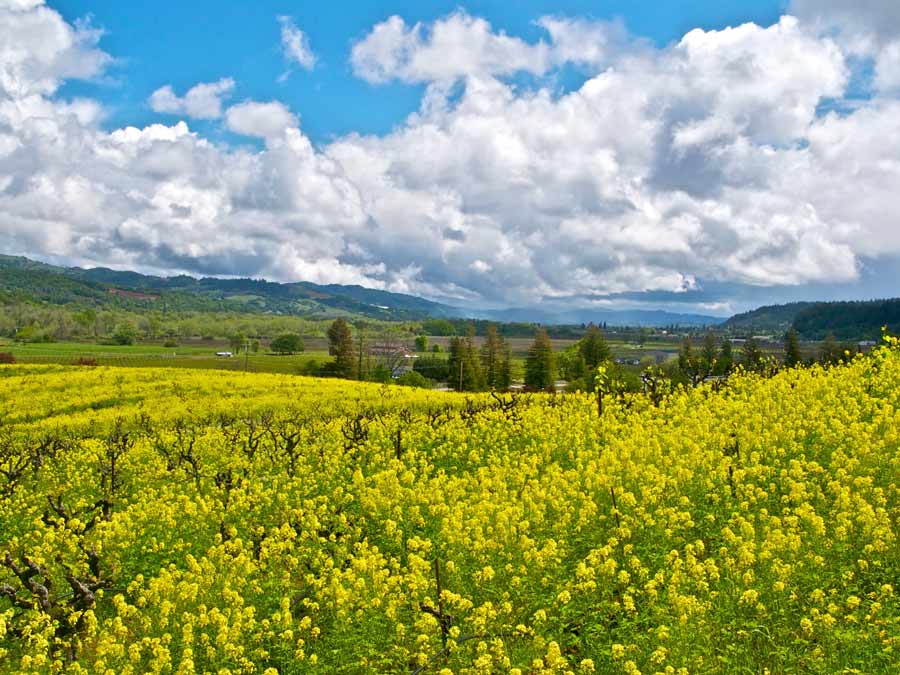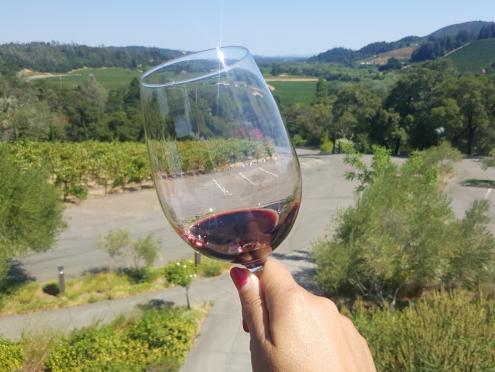
The Magic of Mustard in the Vineyards
Every year, towards the end of winter, many Sonoma County vineyards come alive with a brilliant carpet of mustard showing yellow, orange, and gold beneath the bare grape trunks. The first time someone sees the landscape, it's mesmerizing. Even when they see it again and again, year after year, it never loses its magic.
Together, we can protect and preserve the beauty and natural resources of Sonoma County for generations to come. Check out our page on Sustainable Travel, and look over the Leave No Trace Seven Principles.
The practice holds deep roots in Wine Country. According to legend, a Franciscan missionary first spread the mustard seed while landscaping church properties throughout California. Planting was simple – these early world gardeners carried the mustard seeds in a sack slung over their backs, and each sack had a small hole in it, so as they walked, the seeds would scatter.
To view the mustard, simply pick an area that's deeply populated with wineries and vineyards, and look out your car window.
In Northern Sonoma County particularly lavish displays flourish near Alexander Valley (start from Geyserville), on Guerneville Road along the Russian River (from Santa Rosa to Guerneville), in Dry Creek Valley from Healdsburg, and along Highway 101 heading to Geyserville. Another famous spot for mustard viewing is Highway 12 from Santa Rosa to Sonoma in the Sonoma Valley.
Hiking in the vineyards or adjoining nature parks, such as Sugarloaf Ridge State Park, is also a great way to see mustard in bloom. Or, get details about free self-guided vineyard walks.
Mustard also thrives wild in meadows, laying a luxurious blanket under live oaks. It's beneficial on sloped grades, since the plants hold soil in place during winter rains to protect again erosion. Sometimes, it seems to just pop up overnight, too, in a place that long was barren. That's because mustard seeds have been known to persist in soils for upwards of 20 years, and may have gone dormant but will be revived by specific weather conditions or tractor disking.
For folks wanting to impress their friends with mustard knowledge, here are some details about the plants that will have everyone marveling over the science (and big words) of it all:
- Mustard growth helps suppress nematode population (microscopic worms that can damage vines), because mustard contains high levels of biofumigants
- Some vineyards have created their own varieties that are specifically bred to have high levels of Glucosinolate compounds, or are 'extra spicy,' to further deter nematodes
- Essentially, the worms don't like the glucosinolates in the mustard, which give the plant its pungent odor and sharp taste
- Naturally reducing harmful nematodes with mustard spares the vineyards from dangerous chemical eradicators and pesticides
We all know what a stunning backdrop a field of mustard blossoms makes for portraits and photos, so here are some tips to visiting the mustard fields as sustainably and respectfully as possible, so that they can be enjoyed by all:
- Park on the shoulder or side of the road to take pictures only where it is safe and legal to do so.
- Many of these lands are private and belong to farmers and viticulturalists. Please do not venture into someone's mustard field unless you have direct permission of the owner.
- Please be respectful of the growing blossoms and do not step on, sit on, pick, or otherwise disturb them. These mustard blossoms are doing hard work for the land, and we don't want to disrupt them.
Thank you for helping us keep Sonoma County sustainable and stunning for generations to come. Do share your photos on social media with the hashtag #LifeOpensUp, and pledge to travel Wine Country sustainably below:



